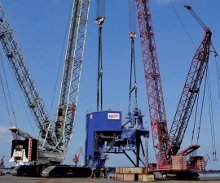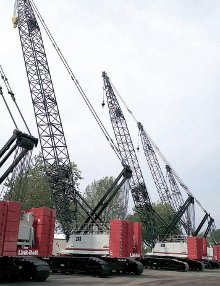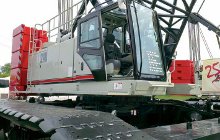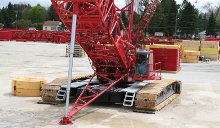Defining the middle
17 October 2012The mid-range of crawler capacities covers equipment working on jobs from general construction through to specialist engineered lifts. Will North speaks to manufacturers about their latest products, and tries to work out just where the middle lies.
In Cranes Today's annual Fleet File, we define medium capacity for crawler cranes between 300 and 600t. That is, however, a very broad range, and excludes a lot of cranes at the bottom of what many think of the mid-range.
Pat Collins, senior lattice boom product manager at Link-Belt, says that in the US, the mid-range starts lower: "In North America, the mid-range is 150-250USt. The beginning of the class is used by general contractors, such as bridge builders and those working on energy infrastructure. They're also used by large regional and national crane fleets.
"Our cranes are busy on the Gulf Coast in the energy sector. We're seeing 248 HSL activity up in the Bakken Field. Business is pretty active at 110USt and 150USt"
Uri Toudjarov, whose company, Global Crane Sales distributes Zoomlion cranes around the world, also sees potential in this market.
He says, "The market is very interested. If you look at the numbers, half is for 220t and below. The largest sales are in 110t.
"In North America, the focus is on 110t machines, then 200t and 220t. We're planning to launch a 120t machine. That's a very large segment of the market."
"There's a lot of interest in construction and bridge building.
"For the market in southern California, the 300t is very popular. They're assembling and disassembling machines several times a year for tilt up work. They're easy to move and transport.
"We're pushing the 260t machine. It's very price competitive. We've got very positive feedback.
"On the 260-tonner, we're able to offer the best of both worlds: ease of transport and capacity."
Link-Belt's Collins agrees that transportability is key in the 100t-250t range: "At the lower end of this this class, mobility and ease of assembly is very important. For the regional guys, without their own dedicated rigging crews, ease of assembly has greater weight.
"The new 238 HSL has been hugely successful. Our shipments indicate we get the lion's share of the market in this class. The 238 moves so easily, it offers good transportation, a good load chart. It is dependable. It has big drums, and a good hoist capacity. It is fitted with guard rails, and with swing and travel alarms.
"The 238 features self-powered hook and pin side frames, allowing it to self-assemble with a 10ft rigging insert. Its transport weight is under 87,000lb."
Jerry Maloney, global product director for lattice boom crawlers at Manitowoc, agrees, "Oil and gas users seem to go for smaller machines. They're constantly moving equipment around, so want to be able to move without too much disassembly."
Terex claims one of the broadest range of crawler cranes in the world. Rüdiger Zollondz, senior manager for product marketing, explains, "In Zweibrücken we have 300t, 350t, 400t, 500t and 600t models. No one else has that sort of range. The main business for is for 400t-600t models, the CC 2400, CC 2500 and CC 2800; the market isn't very interesting for smaller machines.
"We haven't been really present on a global scale with small crawlers. In Zweibrucken, we make crawlers above 300t. Below this we supply North America with US made products and in Asia and emerging markets with products made in Jinan, China.
"In the US we have our legacy American Crane business, with 230USt and 275USt models. They're made for the US market. US customers prefer more simple, rugged machines. They're simple-to-use with direct hydraulic controls. People in the US love them. In China we have the 250t Powerlift 7000 and 360t Powerlift 8000. The Powerlift 7000 had just been launched when we acquired Topower two years ago; the 8000 was launched last year. The 8000 has been very good for wind farm work in China.
The business in China is still developing. We've already sent a few Chinese crawlers around the world, particularly to Africa; we sold one in Algeria recently."
While Link-Belt and Zoomlion are seeing their best sales at the lower end of Cranes Today's defined broad mid-range, Terex still sees its best crawler business in bigger cranes."
Wind powers development
Zollondz says, "The bigger machines have been good models for us. For the applications they are used for, there are fewer alternatives. For smaller jobs where, in the US, people might use crawlers, in Europe they use all terrains. Large international lifting contractors buy their own heavy crawlers, but smaller firms use all terrains.
"There are some big applications, like energy and wind, that start with the 400- tonner and 600-tonner. They'll soon need even bigger cranes.
"We have now a wind attachment for the boom of the 1,250t CC 6800, for use on 5MW wind turbines. The CC 6800 was already able to erect 5MW turbines, with the attachment it can do it more efficiently
and higher turbines."
"In the last two years, we've changed the CC 2400 and CC 2500 to be able to self erect a long boom system. That's again good for the wind turbine industry."
Terex isn't the only manufacturer looking to the wind turbine industry. This sector has also spurred development at US-owned rivals Manitowoc.
Maloney says, "We've developed two major attachment options, the wind attachment and boom raising system, for our 400-tonner, the Model 16000, introduced in 2005 at Conexpo.
"The wind attachment features a brand new heavier boom and extended 7.5m boom point. When working at close radii, the wind attachment increases capacity by about 49%. It's a response to nacelles getting heavier. We wanted customers to be able to use the basic Model 16000 machine for these jobs.
"Customers for the wind attachments get some additional heavy inserts, for a more heavy-duty boom. This allows customers to lift heavy nacelles onto 80-85m towers.
"After we had begun development of the wind attachment, customers started wanting to work on 100m towers. That's why we came up with the boom raising system. This is a specialised cylinder in a special insert that helps get longer booms off the ground. Using the boom raising system, customers can use the crane for 100m towers, and still have the capacity to lift the heavy nacelles.
"The operator manually extends the hydraulic cylinder. That pushes down on the ground, raising the boom to 38°. Then, the boom hoist system can raise the boom by itself; the operator retracts the boom raising system. At the end of the day, the boom is lowered to 45° and the operator extends the cylinder again, to gently lower the boom to the ground. It's tied into the LMI and control system.
"We haven't targeted any new markets beyond wind yet, but I would guess it could also be used for big infrastructure projects like power plants or oil and gas refineries.
"The wind turbine industry has been busy in the US this year. The production tax credit, a subsidy for wind turbine development that is normally renewed by Congress each year, hasn't been renewed this year for 2013. Most people expect it will be passed, but customers are trying to get as much done as possible this year, in case it isn't. That means there will be a slowdown in the first half of 2013. At the last Wind Show, people were busy, getting as much done as they could this year.
"India seems to be an interesting market for the wind industry. Most of their energy production is from coal, and like everywhere else, they are looking to renewables.
"On the higher end, the mining industry is driving some sales, particularly in South America and Australia for 400t and 600t machines. They're being used for new mines and infrastructure."
It's not all about big new changes though. Crawlers at the higher end of this range are sold on a face-to-face basis, and manufacturers often implement incremental changes in line with customer requests.
Terex's Zollondz says, "Fall protection is now available over almost all of this range. It's a must for work on refinery and oil and gas sites.
"There's been a range of improvements, small details that make it safer and easier to transport and erect cranes.
"For the CC 2800, we recently added a 3m section for the light fixed job, to give a little more reach. For some customers, that has meant they can work on a level of wind turbine they hadn't been able to before."
What sells where?
While sales of smaller cranes are picking up in the US, for larger cranes sales managers have a tougher job on their hand. Collins explains, "The bigger cranes that were sidelined are now working. Owners are looking for more long term work for them,
for a commitment from customers. They're also waiting for a commitment from government on the PTC (the production tax credit). Everything is politics at the level: I can't see how you can let that go to the 12th hour, how you can't keep it going."
While Europe continues to struggle, that hasn't effected sales from Terex's German crawler crane, Zollondz says, "Sales out of Zweibrücken for larger crawlers often come from customers who buy in Europe, but operate worldwide. Many machines that were bought last year have moved out of Europe. There are so many contractors who at least operate continent-wide, if not globally."




